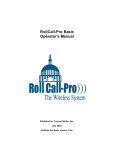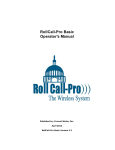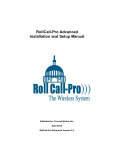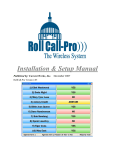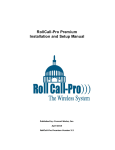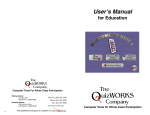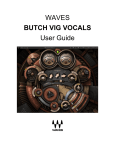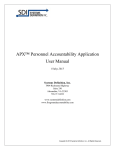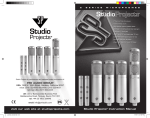Download 4. Using RollCall
Transcript
Operator’s Manual Published by: Current Works, Inc. February 2009 RollCall-Pro Version 2.20 Contents 1. Introduction ……………..….....................……...……. 1-1 2. Site Setup ………………......................……………….. 2-2 3. Starting the RollCall-Pro System ………….……….... 3-3 4. Using RollCall-Pro System …………….......………… 4-6 4.1 Keypad and Screen Controls ……………..….… 4-6 4.1.1 Voter Keypads .…….……………..………. 4-7 4.1.2 Leader’s Keypad …..…………………...… 4-7 4.1.3 Leader Program Options ………………... 4-9 4.1.4 Pre-Loaded Agenda ………….……...…… 4-9 4.2 Roll Call ……………………………………….… 4-15 4.3 Public Timer ……………………….……….…… 4-19 4.4 Discussion …………………………..…………… 4-21 4.4.1 Agenda ……….…………………………… 4-21 4.4.2 Vote Passing Criteria …………..………… 4-22 4.4.3 Motion and Second …………….………… 4-23 4.4.4 Present and Absent ………………….…… 4-25 4.4.5 Request to Speak ………………….……… 4-27 4.5 Roll Call Voting ……………….……....………… 4-29 4.6 Results of Vote ……………….……..…………… 4-33 4.7 Reveal and Record the Vote ……………….…… 4-36 4.8 Continue or Exit ……………….…….………….. 4-40 4.9 Results Saved from a Meeting ………....………. 4-41 5. Trouble Shooting and Customer Service……….…… 5-42 1. Introduction This Operator’s Manual describes how to use the RollCall-Pro System, both the software and the wireless SideKeys keypads, in a meeting. It presumes that you have already used the Installation and Setup Manual to install the RollCall-Pro software program and to create the Configuration Files you will use in a meeting You should also become familiar with the SideKeys User Manual that came with this System. This manual provides valuable information regarding the set, maintenance and trouble shooting of the wireless keypad system. Introduction 1-1 2. Site Setup The following diagram and picture illustrate how to set the system up to work in a City Council Chamber, County Commissioners Room, or any room where the system may be used. Possible scenarios are LCD or large TV monitors hanging in the room, or a projected display of the computer screen onto a white wall or drop-down screen, or a number of other display possibilities. The projection device can either be a portable system or a permanent projector hanging from the ceiling. Figure 2-1. Typical Hardware Setup Figure 2-2. Typical Installation of RollCall-Pro System Site Setup 2-2 3. Starting the RollCall-Pro System Before starting the RollCall-Pro program for use in a meeting, it is recommended that the computer be adjusted so that the computer will not automatically go to a screen saver, to sleep, to hibernation or shut down the screen or any other power saving options. In a normal meeting, there may be extended periods of time when the computer and the RollCall-Pro System will not be used and you do not want the computer to shut down any functions during the meeting. These power-saving shutdown functions could disrupt the RollCall-Pro software program or the USB connection to the wireless keypads and might require you to re-start the software program or the computer in the middle of a meeting. In the “Control Panel” of your computer look for options under “Display Properties”: in the “Screen Saver” file choose “None” for Screen Saver. Figure 3-1. Control Panel’s “Display Properties” Starting RollCall-Pro 3-3 In the “Control Panel” of your computer look for options under “Power Options”: In the “Power Options” choose “Never” for all options Including: Turn off monitor, Turn off hard disk, System standby, System hibernate. Figure 3-2. Control Panel’s “Power Options” Note: If you are using a Laptop Computer always have the computer plugged into an external power source; it is not recommended to run this program off of batteries. Special Note: If you are using a Dell™ computer you may also need to use a USB hub with an external power supply between the computer and the USB SideKeys Receiver. This will ensure that the required standard 5 volts of power is always available to the SideKeys Receiver. To start RollCall-Pro program: Double-click on the icon on your desktop. Starting RollCall-Pro 3-4 The shortcut will open the RollCall-Pro System Welcome Screen displays: Figure 3-3. RollCall-Pro System Start Screen Click on this Screen’s “Start” button, choose a previously saved configuration and “Open” it. If you need to make changes in the Configuration File, right-click in the application screen to display a list of options; select “Hide/Unhide Tabs” then select the Setup or Option Tab to modify your configuration as needed. See the RollCall-Pro Installation and Setup Manual: Section 3 for details about these options. Update your Configuration as necessary and don’t forget to Save your configuration changes. Starting RollCall-Pro 3-5 4. Using RollCall-Pro System The RollCall-Pro screen displays as below. Figure 4-1. RollCall-Pro Display Screen Notice the last row at the bottom of the screen. The first field indicates the current item or issue. The middle field indicates the action to be taken (roll call, discussion, voting, etc.). The third field indicates the criteria required (Majority, 2/3, ¾, No Vote Req’rd, Custom) for the current item to pass. 4.1 Keypad and Screen Controls The keypads and program options are used to move the participants through the voting session. Using RollCall-Pro 4-6 4.1.1 Voter Keypads Each voter will have a wireless keypad like this one: Each voter has a wireless keypad with 6 active buttons for: Figure 4-2. Wireless Member Keypad Each of these functions will be discussed in detail below. 4.1.2 Leader’s Keypad The Leader will have a keypad like the one illustrated here: The Leader’s keypad has six buttons available for controlling the functions of the RollCall-Pro System. Figure 4-3. Wireless Leader’s Keypad Using RollCall-Pro 4-7 The Proceed (Speak/Vote) button (top left, green button on the keypad) advances the RollCall-Pro software through the meeting. This will be explained in detail below. This “Proceed” function can also be accessed from the computer running the software program: either with the “z” key on the keyboard or by “Left-Clicking” the mouse cursor on the small “ >” icon in the bottom right corner of the Display screen The % to Pass button adjusts the criteria to pass the Item being voted on. This function can also be accessed from the computer – either by using the “Period” (“ . ”) key on the keyboard or by “Left-Double-Clicking” the cursor on the Criteria field in the lower right corner of the display screen during the Discussion mode of the meeting. The Swap button allows the Leader to switch between the RollCall-Pro software program and any other software application, like PowerPoint, an Excel Spreadsheet, or a Word Document. The Next and Back buttons allow the Leader, when in PowerPoint Slideshow presentation, to remotely advance the presentation, forward and back, respectively. The Lock Out button locks out all other wireless keypads, except the Leader’s keypad. This is useful when the Leader needs to stop the use of keypads for any reason. (e.g., when the Clerk needs to type in revisions to the Agenda during a meeting, or when a vote must be Cancelled, or when a Word doc is projected and you don’t want text from the keypads inserted, or when a PowerPoint presentation is being given and some text input might interrupt the presentation). Use of these functions will be discussed in further detail below. Using RollCall-Pro 4-8 4.1.3 Leader Program Options The Leader will also have a desktop or a laptop computer from which RollCall-Pro software is executed, updated, and Results saved. There are several functions available to the Leader by clicking the mouse on the RollCall-Pro display screen. To initially access these options simply right click anywhere on the display screen for the popup window of options. Then left click on the choice in the pop-up window: Figure 4-4. “Right Click” Pop-up Menu Screen 4.1.4 Pre-Loaded Agenda (Optional Feature) If you want to use a Pre-loaded Agenda that you have created for this meeting (see the Installation and Setup Manual , Section 3.3 for more details) you need to select the “Hide/Unhide Tabs” option from this pop-up window. Figure 4-5. Left Click on the “Hide/Unhide Tabs” option in the pop-up window Using RollCall-Pro 4-9 Then select the “Agenda” tab to open the Agenda Screen page. Figure 4-6. Select the “Agenda” Tab The small Hint window, suggests that you press the “Lock Out” button on the Leader’s Keypad before typing into this page. This is important if Board/Council Members have their Voting keypads in their hands while you are typing. If these members hit any keypad button, while you are trying to type, they will send disruptive keystrokes (like:\101\109\407\206) into your text. If the Keypads are not in use, there is no need to be concerned about this, simply Click “OK” and go on. Figure 4-7. Lock Out Keypads --Suggestion Using RollCall-Pro 4-10 A similar Hint window will appear when you exit this page to remind you to press the “Lock Out” button on the Leader’s keypad again, this time to unlock the members’ keypads for use in the meeting. Figure 4-8. Un-Lock Keypads --Suggestion The first Step in working with the Agenda page is the requirement to Load an Agenda. You can load any Agenda available, the first time you might load the “Example” Agenda. Thereafter, you might want to start with your previous Agenda and modify it for the next meeting. Figure 4-9. Click on the “Load Agenda” button Left Click on the “Load Agenda” button on the left to select the Agenda you wish to load. This will open a Selection Window to choose a new Agenda, or perhaps one that you have already created for this meeting. Using RollCall-Pro 4-11 Figure 4-10. Saved Agenda to Select from The chosen Agenda will be loaded for the meeting and will be displayed on the Agenda page. You can view each Agenda Item by selecting “Next Agenda Item” or “Previous Agenda Item” to move through the list. You can also print the contents of any selected Agenda Item, if desired, by clicking on the “Print Agenda” button on the left side. You can preview the entire Loaded Agenda by clicking on the “Preview Current Agenda” and choosing the Agenda name. This entire Agenda can also be printed by selecting Print Agenda when the entire Agenda is displayed. Using RollCall-Pro 4-12 Figure 4-11. Preview of Example Agenda When the desired Agenda is loaded before the meeting starts, the “Item Names” (Default is “Item 1” & “Item 2” , etc.) on the bottom left field of the Discussion and Voting Screens will automatically be replaced by the “Agenda Item Short Description” that you created for each Agenda Item. Likewise the “Criteria for Passing” on the bottom right field of these screens will be replaced with the Criteria you entered for each Agenda Item. These Names and Criteria will also be used in the Results that are saved for the meeting. If you have entered the full text of the Agenda Item into the Agenda, you have the option of opening the Agenda page at any time during the meeting to display the full text of the Agenda Item. You can also insert an additional Agenda Item at any time during the meeting (e.g. when there is an Amendment to the Resolution that is proposed and needs to be discussed and voted on prior to the vote on the original Resolution). Using RollCall-Pro 4-13 Figure 4-12. Insert Agenda Item screen When you are on Agenda Item 4 and wish to Insert a new Item 4, just left click on button “Insert Agenda Item”. A Popup window announces that a “New Item 4 inserted into Agenda” the previous Item 4 will now be listed as Item 5 and all other Items will also be moved down the list accordingly. So if the Amendment passes, the original Resolution will need to be changed to reflect the Amendment, before it is discussed and voted on. This change can be noted in the Short Name of the Item and/or in the Body of the Resolution, if desired. (e.g. Res. 212 +Amend) Likewise if an Item is to be dropped from the Agenda, for any reason, it can be “Deleted” from the Agenda & all following Items will be brought forward by one number in the list of Items for the meeting. Likewise if during the discussion of an Item, it becomes clear that the Item will not be voted on in this meeting, the Criteria can be changed to “No Vote Required”. With that, the Discussion results will be saved, but no vote is registered and the “No Vote Required” will be recorded in the Results document. If there are any changes made to the Agenda during the meeting, they should be saved and the full Agenda should be printed at the end of the meeting, as a part of the input to the minutes of the meeting. Using RollCall-Pro 4-14 4.2 Roll Call 1. To begin the meeting the Leader will push on the “Proceed” button on the Leader’s wireless keypad, or the “z” key, or click “ >” to display the Roll Call Screen, ready for Members’ input. Figure 4-13. Initial Start up Screen Figure 4-14. Ready for Members’ Roll Call input Using RollCall-Pro 4-15 2. The Voting Members push their “Yes (Present)” button and then their “Confirm” button to indicate their “Presence” in the initial Roll Call for the meeting. The screen will display the Present members and count the numbers of Voters logged in, verses the minimum quorum required. Figure 4-15. Member’s Keypad Figure 4-16. Roll Call in process Using RollCall-Pro 4-16 3. After all the Members who are actually Present have Confirmed their Presence, the Leader presses the Proceed button again on the Leader’s keypad or hit the “z” key , or click the “ >”. The Voting Screen will display those who are “Present” and those who are “Absent”. Note: The Keypads of those “Absent” members can not be used to mark them Absent. They automatically become Absent when the program is advanced with the Proceed function. Figure 4-17. Roll Call completed at beginning of meeting Note: The meeting can continue only if the number of voters present equals or exceeds the Quorum number set in the configuration file as the minimum number of members required for the meeting to proceed. Using RollCall-Pro 4-17 4. If there are not enough members for the meeting to continue, the bottom center field will indicate that there are insufficient members for the meeting to proceed. Figure 4-18. Message indicating a Quorum is not yet present 5. If there are at least the Minimum Number of Voting Members to conduct business, the screen will display the Members “Present” and those “Absent”. A record of the Members who are “Present” and “Absent” during this Roll Call is also documented in the Results file for this meeting. 6. If, in the Setup options, you have selected the “Automatically Print the Results after each Vote”, this initial Roll Call screen will be printed automatically when the results are saved. 7. If a Member arrives late to the meeting after the Roll Call is completed, they can be marked Present by the Clerk or by their own Keypad, if that option is allowed. The actual time they are marked Present is Time Stamped in the Results File. Using RollCall-Pro 4-18 4.3 Public Timer (Optional Feature) If there is a request for Public Input to the Board and you have a prescribed time limit on such input, the Public Timer may be utilized to visually manage this time limit. The Timer is accessed in the popup window when you right-click the mouse on the RollCall-Pro Display Screen. Figure 4-19. Display for Public Timer with up to Fifteen Minute Time Limits Once you have selected this item, a window with a large green circle appears with the wording that “Set for 3 Minutes”. You can adjust this time limit by moving the slide bar with the mouse to choose from 1 to 15 minutes. To begin the timer, just left click your mouse on the “Start” button. Once the timer has started, the time is counted down in seconds. When the Timer gets down to 60 Seconds, the color of the chart changes from Green to Yellow by the second. Then at 15 seconds remaining, it changes again to Red color. Using RollCall-Pro 4-19 Figure 4-20. Display for Public Timer with less than One Minute Remaining Figure 4-21. Display for Public Timer with less than 15 Seconds Remaining And finally, when the time is up, the color will be red and the display will show, “Time Exhausted”. Figure 4-22. Display for Public Timer with No Time Remaining Using RollCall-Pro 4-20 4.4 Discussion After the Startup Roll Call is completed, the Leader pushes the Proceed button (or the “z” key or the “>”) again to display the Discussion Screen for the first agenda Item. Figure 4-23. Discussion Screen for Item 1 (here named Res. 1357-09) 4.4.1 Agenda If a pre-loaded Agenda was selected before the meeting started, the “Short Name” (e.g. Res.1357-09) of the first Agenda Item will appear at the bottom of the screen. If the Agenda needs to be accessed at any point in the meeting, right click anywhere on the screen to reveal the popup window where you can select the Hide/Unhide Tabs option. Then select the Agenda Tab. See Section 4.1.4 above regarding the Agenda page. Using RollCall-Pro 4-21 4.4.2 Vote Passing Criteria If necessary, the leader can change the Vote Passing Criteria displayed in the third field at the bottom of the screen by pushing the “% to Pass” button on the Leader’s keypad, or by pressing the period “.” key on the computer keyboard. Either of these will scroll through the standard options until the desired choice is displayed in the field: Majority Vote (51%), 2/3 Vote (67%), 3/4 Vote (75%), or No Vote Req’rd. If you wish to change this Voting Criteria to a fixed number of Yes votes to pass, you must double left-click on the Passing Criteria field (bottom right corner of screen) during the Discussion phase, prior to the Vote. When this Passing Criteria is accessed by double left clicking the mouse, after the “No Vote Req’rd” criteria appears, the next double click will provide a popup window to input the “Number of Yes Votes” required to pass the Item, regardless of how many voters are present. Figure 4-24 Entering a Fixed Number of “Yes” Votes require to Pass the Item Using RollCall-Pro 4-22 4.4.3 Motion and Second (Optional Feature) If the Motion and Second function is to be utilized for this Agenda item, the Clerk begins the Motion process by Left-Clicking on the “Discussion” field next to the member who is Making the Motion. A popup box appears to Confirm that this is the correct Member and to question if another Member wishes to Second the Motion. Figure 4-25 Identifying the Member who Makes the Motion If it is the Correct Member who wants to Make the Motion, the Clerk selects “Yes” and any other Member can Second this Motion by pressing the “2nd The Motion” button on their own Keypad. Figure 4-26 Second the Motion Button on Members’ Keypad Using RollCall-Pro 4-23 The first person to push this button will be identified as the Second. Another popup window will confirm that the Motion has a Second and that this will be recorded in the Results document. Figure 4-27 Confirmation that the Motion has a Second When the Clerk confirms the Member who Made the Motion is identified with the letter (M), the Member who Seconds it is identified with the number (2). Figure 4-28 Motion has been Made and has a Second Using RollCall-Pro 4-24 If a Motion is properly Made by a Member, but no one Seconds the Motion, the only option for the Board is to have the Clerk “Withdraw the Motion” for lack of a Second. This option is available on the popup screen when the Clerk “Right-Clicks” anywhere on the screen, and then selects the option “Withdraw Motion”. Then select “Yes” to return to the Discussion screen. Figure 4-29 Motion is Withdrawn for Lack of a Second 4.4.4 Present and Absent If the Business Rules allow the voters to personally indicate when they need to leave the meeting for a period of time, the voters can push the No (Absent) button on their wireless keypad, during the Discussion phase of the meeting, to indicate that they are leaving the meeting. When they return, they must press their Yes (Present) button so that their status returns to “Present” – if their status is “Absent” when the next Voting phase is entered, they will not be able to vote, until they are marked “Present”. Likewise, Voters who were absent at the initial Roll Call can push their Yes (Present) button when they arrive late to the meeting. The Presence and Absence of each member is recorded and time-stamped in the Results document of the meeting. The Leader has an overriding function that can be used to change the “Present/Absent” status of any Member during the “Discussion” phase of a meeting. If a Voting Member forgets to use the keypad to declare herself as “Absent”, the Leader can double-left click on the Member’s Name and a small pop-up message window will appear. In the example below, the Leader double clicked on “Doris” and the following message popped up. To change Doris’ display to “Absent”, click “Yes”. To leave things as they are, click on “Cancel”. Using RollCall-Pro 4-25 Figure 4-30. Clerk changing Present to Absent Once the Leader chooses “Yes”, the display will look like the following: Figure 4-31. Member status after being marked Absent Note: This same sequence can be used to change the “Absent” status back to a “Present” status. This “status change” function can be done by the Leader during either the “Discussion” or the “Voting” phase of the meeting. So if a Member is shown as “Absent” during a Vote, the Leader can mark them “Present” and available to Vote, before the voting process is completed. This function is always active for the Leader to use, whether the Voting Members are allowed to change their own status or not. Every “Change of Status” change is time stamped & recorded in the Results of the meeting. Using RollCall-Pro 4-26 4.4.5 Request to Speak (Optional Feature) If the “Request to Speak” option has been selected in the Options Tab Business Rules, during the discussion phase, the voters can click on their keypad’s “Request to Speak” button to be queued for their turn to join the discussion. Their intent to speak and their position in the queue are displayed on the Discussion Screen. Figure 4-32. Member’s Requesting to Speak –in the Queue The voter with the “ <== Speaking” designator to the right of his/her name is the current speaker; when the current speaker is finished, the Leader pushes the Proceed (Speak/Vote) button on the Leader’s Keypad (or the “z” key or click on the “ > ” ) to proceed on to the “ <== Next” speaker. If a Member, still in the queue, decides they want to remove themselves from the queue, they push the “Abstain (Cancel RTS)” button on their keypad. They can still rejoin the queue again later by pressing their RTS button again. When Members are recognized to be the Speaker, their name and time stamp are recorded in the Results document. Using RollCall-Pro 4-27 Figure 4-33. Proceeding through the Queue of Speakers The Leader continues to recognize each Speaker in the queue by pushing the Proceed (Speak/Vote) button when each speaker is finished until the following screen is displayed: Figure 4-34. All Members who want to Speak have been recognized Using RollCall-Pro 4-28 If there are no more requests to speak and the Members are prepared to Vote on the Item, the Leader again pushes the Proceed (Speak/Vote) button to begin the Voting phase. Figure 4-35. The Roll Call Voting Process begins 4.5 Roll Call Voting 1. The members vote on the Item by first pushing their Voting buttons: Yes, No or Abstain (if “Abstain” is allowed). Then the Members lock-in their vote by pushing the Confirm button. Note: Members can change their mind on how they wish to vote until they push their Confirm button. At that point, the last choice they made, just before Confirm, is locked in. Using RollCall-Pro 4-29 The Voting screen will first display “Confirming” on a yellow background when each member pushes their Vote button. When they lock-in their vote with the Confirm button, the Voting screen displays “Vote Locked”. Note that the votes are identified by the ‘Confirming’ and ‘Vote Locked’ status, not by a “Yes” or “No” or any other indication of how each member voted. This allows everyone to vote without being unduly influenced by how others have voted. Figure 4-36. Voting in Process Using RollCall-Pro 4-30 Reset a Locked Vote: This system has an option to individually reset an individual Member’s vote, before the full Voting Results are revealed. During the Voting phase of a Session, a member’s “Vote Locked” status can be reset back to “Voting”, if the Leader double-clicks on the Voter’s name and chooses to reset the vote. In the following example, Voter “Billie Jean Queen” has voted and already locked in her vote by pushing the “Confirm” button on her keypad. If Billie has determined that for some reason she needs to reset her vote, the Leader can reset his status to “Voting” and allow her to vote again. Figure 4-37. Resetting an Individual’s Vote In this popup window, if the Leader chooses not to reset the vote, the Leader would click on the “Cancel” button and the locked vote would remain the same. If the Leader does choose to reset the vote, then the Leader would choose “Yes” and Member would have the opportunity to vote again. The following shows the resulting display after resetting Billie Jean’s vote. Figure 4-38. Billie Jean’s Vote is Reset Note: A nice feature of the Leader option to reset votes, combined with the business rule for the Leader to control the revealing of the displayed vote, is that the Leader would be given the opportunity to announce a “last call” or to ensure that each of the voters had indeed locked in their final choice. If someone truly needs to change their vote or to vote again, then this would be the opportunity. This is not an ideal situation, but it does allow the Leader to ensure that everyone is set before the votes are revealed. Using RollCall-Pro 4-31 Cancel the Vote: This system also has an option is to Cancel the entire Vote, if necessary, before the votes are officially revealed. If there is a reason to cancel the vote and start back at the Discussion of the Item, before the final vote is revealed, the Leader must right click anywhere on the screen to get the popup screen of options. One of these Options is “Cancel Vote”. Figure 4-39. Right-Click Popup Options Left Click on the “Cancel Vote” menu option, and then the system will ask you to confirm your cancellation, Select “Yes”, and then press the “OK” button and then, press the “Proceed” (Speak/Vote) button on the Leader/Clerk’s keypad or the “ z ” key on the keyboard or click the “ > ” to return you to the Discussion phase of the Current Item.. Figure 4-40. Are you sure? And Then Click OK and Press “ Proceed “ Note: You must “Proceed” after “OK” Using RollCall-Pro 4-32 4.6 Results of Vote Once all votes are in and confirmed, the individual votes are displayed next to each voter’s name. The votes can be revealed in one of two ways. The default in the Business Rules (“Options” tab) is to display the voting results as soon as the last voting member locks their vote. The alternative is to announce that all votes are Locked and the Leader must press Proceed to reveal the Voting Results. Either way, the individual votes are not revealed until all members have locked in their votes. Figure 4-41. Votes are Locked and ready to be revealed by the Leader Using RollCall-Pro 4-33 Figure 4-42. Votes are Revealed When the Votes are revealed, the field at the bottom of the screen displays the status of the vote, whether it “Passed” or “Failed”. The number of “Yes” votes required to pass an item or resolution depends on the “Criteria to Pass” selected and displayed at the bottom right corner of the screen, before the vote was started. If the First Position Voter is designated in the Business Rules to only vote in case of a tie, she/he does not vote unless a tie is indicated. In case of a tie, the Voting Screen will indicate the need for the Tie Breaker to vote. The specific votes of other Voting Members are not displayed, until after the Tie Breaking vote is cast. Using RollCall-Pro 4-34 Figure 4-43. Tie Breaker Voting Required and the Votes are Revealed The Member designated as the tie-breaker then casts his/her Yes or No vote and then presses Confirm to lock in the final vote. Once the tie breaking vote is locked, the individual votes are all displayed, as usual. Using RollCall-Pro 4-35 Automatic or Delayed Display of Votes: Normally, once the last Member’s vote has been confirmed, the results are automatically displayed. An alternative business rule delays the display of the results and gives the control to the Leader. In some cases, it’s preferred that there is a delay before revealing the results. In these cases, a Business Rule can be set so that the Leader will control when the results are revealed. When this is desired, the Leader must click “Proceed” to display the Voting Results. A status message will display at the bottom of the display board and will notify the Leader when all the votes are Confirmed. Figure 4-44. Ready to Reveal the Votes Message 4.7 Reveal and Record the Vote Once the votes are cast and displayed, the Leader again pushes the Proceed (Speak/Vote) button to reveal the vote and confirm that it was a good vote. The next step in the program is to record the results (if the Configuration File requires the recording of the results). If the “Auto Print the Results after each Vote” is selected in the Setup options, the computer will also immediately send a screen shot of these Revealed voting results to the printer, when the Results are Saved. This print out will show the Vote cast by each Member, and along the bottom line of the screen will be the Short Name of the Item, if one was entered into the Agenda page, the summary of the Voting Results: Passed/Failed, along with # Yes , # No, # Abstain, # Absent and then the Criteria for the Vote to Pass (just a seen in Fig. 4.42) Using RollCall-Pro 4-36 The screen below indicates that RollCall-Pro is in the process of recording results: Figure 4-45 Recording Results in the record Using RollCall-Pro 4-37 The results will be saved as a text file or a comma delimited file (.csv format) , depending on the option you previously selected in the Setup File. If the text file option was selected, the results are saved in the following format: Figure 4-46 Results Document in Text Format Using RollCall-Pro 4-38 If the comma delimited file option was selected, the results display as follows: Figure 4-47 Results Document in .csv Format The comma delimited file can be interpreted as follows: The first field (1,2,3, - - n) = Item Number The second field (P, NP) = Present, Not Present The third field (1 - - n) = Position of Person on Voting Member List The fourth field = Name of Voting Member The fifth field (Y,N,A) = the Vote cast by the Member (blank = no vote, Absent) Using RollCall-Pro 4-39 This Results file indicates that for Item 1, Dave Made the Motion, Second by Oprah and 8 votes were cast; and that ‘Member 2 & 4 ’ were Absent for the Discussion and the vote, which was noted with an ‘NP’ designation. The RollCall-Pro System results file is created and the name of the file is embedded with the current date (Example: “2_15_2009.txt”). If an additional meeting is held on the same date, the software first checks to see if a results file exists for the current date and if so, prompts the user to either append the results to the current results file or to add another new results file in the Results Folder. If the user chooses to add another results file, the naming convention of the result file would be today’s date with the time (Example: _2043, as shown here) added to the end. For example, if the user chooses to create a new results file by choosing “No”, then a new results file is created, with the time added to the date in the documents name. Figure 4-48. Select Yes = Same meeting, or No = New meeting For example, if the date was Feb, 16th, 2009, and the time was 8:15pm, then a new results file would be created with the name of 2_16_2009_2015.txt”. Note the time is in military format, or 24 hour notation. 4.8 Continue or Exit Continue with a discussion and a vote on another item by clicking on the Leader’s Proceed (Speak/Vote) button; or, if the meeting is finished, exit RollCall-Pro by right-clicking on the screen to display the list of options, then selecting the ‘Exit Voting Pro’ option. The “Are you sure” window will always pop up to confirm that you do wish to Exit before proceeding. Using RollCall-Pro 4-40 Figure 4-49. Exit RollCall-Pro Process If there is an unsaved Voting Results that did not yet get recorded, the following window will also popup to request that you proceed to save the Results before Exiting the program. Figure 4-50. Exit, After Saving Results When the RollCall-Pro software is closed through this “Exit” function, the End of the Meeting is also Time Stamped in the Results document. 4.9 Results Saved from a Meeting If, in the Setup Configuration Files, the “Record Results” has been selected, they will be saved at the location specified. The Default location is in (C:\ProgramFiles\RollCall-Pro\Results). The RollCall-Pro software program will automatically install a shortcut on your desktop to the “RollCall-Pro Folders”, where the Results Folder is located. Using RollCall-Pro 4-41 The saved file will be labeled according to the date of the meeting (e.g. 10_05_2008.tyr). This report, if saved as a “text file” (.txt) can be copied and pasted into any other Word Processing program, like MS Word, to become a part of the recorded Minutes of the meeting. If it is saved as a “comma delimited file” (.csv) it can be imported into any other database or spreadsheet program, like Excel, to become a part of the recorded Minutes of the meeting. Note: You may go view the saved Results document before the meeting is finished, but you must close the Results document down before returning to the meeting, where additional Voting Results will be saved. The Voting Results cannot be saved to an “Opened” document and in some cases, an “Error Message” may occur when the program tries to save additional Voting Results to a document that is opened. 5. Trouble Shooting and Customer Service If the RollCall-Pro software program does not seem to be responding to signals from any of the wireless keypads, the following trouble shooting steps should be tried, in the order given. 1) Be sure that the RollCall-Pro screen is active and available to accept input from the keypads. Left-Click the mouse on theRollCall-Pro screen to assure it is active; try the keypads again. 2) Be sure the keypads are not “Locked Out” by the Leader’s keypad. The red LED on the Receiver blinks on and off when the Lock-Out function is on. Turn off the “Lock-Out” by pushing the “Lock-Out” button on the Leader’s keypad. 3) Be sure that the USB Receiver is properly connected to the computer. The red LED should be glowing next to the RollCall-Pro label on the Receiver. If the red LED is not on, unplug and re-plug the USB cable, at both ends, just to be sure that full and proper connections are being made. Using RollCall-Pro 5-42 If the red LED is glowing, but is not next to the RollCall-Pro/Voting-Pro label, push the small red button on the side of the Receiver (if there is one) to scroll the LED to the RollCall-Pro or the Voting-Pro template. The USB cable connecting the computer and Receiver should be uncoiled, free to dangle. This Radio-Frequency Receiver cannot be resting on a metal surface; try moving it to different locations. If some of the keypads do not seem to work, try the following trouble shooting steps. 1) Try installing new “alkaline 9-volt batteries” in the defective keypad(s). 2) Be sure that the all Voting Members have the correct keypad. If Voters have the wrong keypad they may not think their keypad is working properly. 3) The Radio Frequency keypads can not be resting on a metal surface, this will seriously limit the range of the radio frequency signal. Try moving it to another surface. If none of the keypads or the mouse or the keyboard works on the software, be certain that all sleep, hibernation and power saving settings are turned off on the computer. If the program RollCall-Pro software will not advance when the “Proceed” button on the Leader’s Keypad or the “z” button on the computer keyboard is hit – be sure that the Caps-Lock key has not been depressed. You must turn off the Caps-Lock key, before the software will respond to the keystroke inputs. If the problem can not be fixed with these steps, please contact Customer Service: Current Works, Inc. 1395 Horizon Drive Johnsburg, IL 60051 1 (888) 526-1200 Email: [email protected] www.rollcallpro.com Using RollCall-Pro 5-43













































